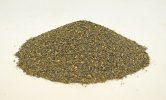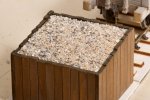PhilH
Western Thunderer
I've been looking for suitable ballast for my narrow gauge layout, something a bit more varied in colour and size than the usual ballast aggregate, and obtained this from a local river:
Its been passed through a sieve, so the maximum size of the sample is probably just under 1mm, and there are fines in it although it doesn't show in the sample. If you have the opportunity its probably worth scouting round the area your model is based in for any natural material, old gravel pits, river banks, etc. The inside of a curve in a river is the most likely place to find deposits of such material.
Mainline ballast is 2" nominal size, or at least that's what Penmaenmawr Quarry was supplying to BR in the 1960s when I worked there. Whether the specification has changed since or not I don't know.
Its been passed through a sieve, so the maximum size of the sample is probably just under 1mm, and there are fines in it although it doesn't show in the sample. If you have the opportunity its probably worth scouting round the area your model is based in for any natural material, old gravel pits, river banks, etc. The inside of a curve in a river is the most likely place to find deposits of such material.
Mainline ballast is 2" nominal size, or at least that's what Penmaenmawr Quarry was supplying to BR in the 1960s when I worked there. Whether the specification has changed since or not I don't know.



